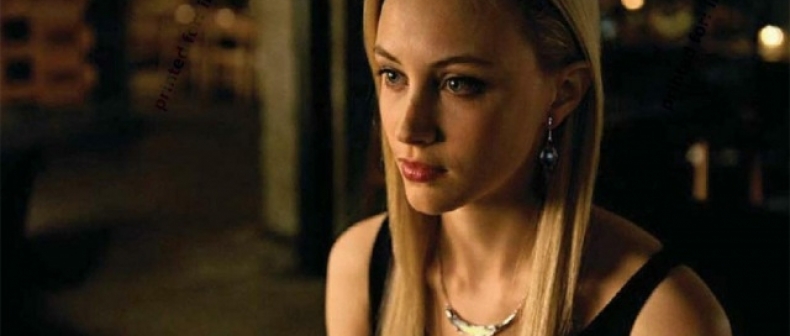
Pictured: Sarah Gadon in Cosmopolis. Image: Screenshot from Cosmopolis
This is part one of an exclusive one-on-one interview with actor Sarah Gadon. Part two will run early next week.
Toronto actor Sarah Gadon’s latest film is a David Cronenberg adaptation of Cosmopolis, a short novel by Don DeLillo. The film premieres this Monday at the TIFF Bell Lightbox. In it, Gadon plays Elise Shifrin, a privileged poet newly wed to billionaire asset manager Eric Packer (Robert Pattinson). The film portrays civilization as an intricate but flawed equation, a system seemingly strong but ready to snap, as Packer rolls through Manhattan on a single-day odyssey in a marble-lined limousine.
Expansive but brief, the novel is dense DeLillo material. That said, there’s space in any book that is open to interpretation. When moved onscreen, our initial reaction is to gauge an adaptation on its closeness to, or distance from, its source material. But books are interpreted by directors and actors, translated to a different language and passed to the screen. Stitched together these readings make a movie. Wondering how Cosmopolis was translated to film, I asked Gadon.
Full disclosure: Gadon and I have been friends for a number of years.
Image: Tim Leyes
In prepping for Cosmopolis, where did you start?
Sarah Gadon: I started reading the book as soon as I found out that I would be a part of the project. Then I ran into David, who said, “I don’t think you should read the book. It’s different [from the film], and it might influence you in a way that I don’t think would be right for the project. So I stopped reading. I think he was right to say that. From a character perspective, it’s different playing a real person than words on a page. Pulling a character from a script is a different transformation.
What impact does that have on your interpretation of character?
SG: A writer like DeLillo crafts his characters with so many layers. There’s such a density and richness to them. When I read the script, I didn’t feel confined by the description of Elise. Later, when I was reading the book, I still felt I could dive into the character. I don’t feel that working without the source material limited me at all.
It sounds reductive, but I found Elise pretty enigmatic, because we only see her from Eric’s perspective in the book and through their detached communication. How do you pick up on queues beyond the script? When you’re sharing scenes?
SG: More than what goes on in the book–or the script–your character is defined by who’s cast as the lead. Whoever’s cast in the Eric Packer role defines the standard of normalcy in the script. But I like that Elise and Eric don’t know each other. It’s rare to play against a romantic lead while the action in the script is based on that fact.
What is Cronenberg’s involvement? I’ve heard there are no rehearsals.
SG: No, we don’t do rehearsals. But David does a very thorough blocking of the scene before going to camera. It’s like a mini rehearsal where we work out the movement of the scene. But I feel less rehearsal added to the project. There’s so much secrecy, security and mythology surrounding Rob as a person that when you arrive on set and do your scene with this actor and never spend any significant time with them, it feels bizarre. That’s what our characters are like: Two people who don’t know anything about each other. They never seem to find each other and when they’re together and it’s like they’re speaking two different languages. And then they both disappear into the city.
Right, Eric is hermetically sealed from the city in this marble-lined limo and Elise is a recluse. They’re removed from the city–
SG: Right. And because we shot a lot in the studio, we felt so far removed from everything. That’s what I like about the characters. They’re in New York City, but they never interact with their environment. It’s almost alarming whenever the environment interacts with them.
John Updike, reviewing Cosmopolis in the New Yorker, saw the book as “Nouveau roman meets Manhattan geography under sci-fi moonlight.” Nouveau roman places character at the feet of details in the surrounding world and the other people there. It’s like: sketch plot, pencil in character and drop them into their surroundings.
SG: But it’s troubling to categorize the book as Nouveau roman or sci-fi because that misses the mark. I see DeLillo removing his characters from their environment in order to call attention to that remove. It’s the lack that you have to focus on. He’s not weaving them into their environment so he can call attention to capitalism and its breakdown–it’s the opposite. David does the same thing in the film. He’s not trying to weave you into the narrative emotionally. He’s trying to create a distantiation where you can intellectualize the material on screen versus committing emotionally to some sort of narrative. You’re being provoked and frustrated into thinking about the system.
So what commentary does the film make? The book is pretty condemning–
SG: Yeah! This is for the one percent descending from their yacht at Cannes to watch a film that points to a gap in society. I think the movie lends itself to a meta-critique of the film industry. Take casting someone like Rob at the centre of this film. He is the symbol of pop cinema, the symbol of capitalism. The film is about the breakdown of that.
And his character’s so hubristic. He tries to tap into this technological system that’s supposed to order the world around him, the dollars and cents of his life, the free market. And we watch it all fall–really hard.
SG: When I read critiques of the film, I think people miss what you’re saying. They ask, “Why is Robert Pattinson in this movie?” Even for David to cast somebody like me who is blonde, blue-eyed and twenty-five and normally reads scripts where I am hyper sexualized or solve everyone’s problem with my smile. He cast me as a character who will not allow her romantic lead to project anything onto her that she will absorb, it’s kind of unheard of. And there is a difference between [Elise] in the book and the Elise that David wrote. In that the last scene between Eric and Elise, in the book, Eric projects onto an accepting Elise. For me, the best part about ending their narrative in the restaurant, in the movie, is that she ends it and she’s out and that’s it.
—
Eli Yarhi is a writer-editor from Toronto.
For more, follow us on Twitter: @TorontoStandard and subscribe to our Newsletter.














